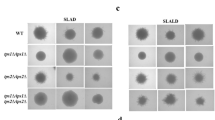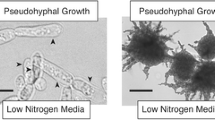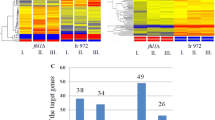Abstract
Diploid cells of Saccharomyces cerevisiae undergo pseudohyphal differentiation in response to nutrient depletion. Although this dimorphic transition occurs due to signals originating from carbon and nitrogen limitation, how these signals are coordinated and integrated is not understood. Results of this study indicate that the pseudohyphal defect of the mep2∆ mutant is overcome upon disruption of KRH2/GPB1 but not KRH1/GPB2. Further, the agar invasion defect observed in a mep2 mutant strain is suppressed only by deleting KRH2 and not KRH1. Thus, the results presented indicate that MEP2 functions by inhibiting KRH2 to trigger filamentation response when glucose becomes limiting. Biochemical data and phenotypic response to glucose replenishment reveal that KRH1 and KRH2 are differentially regulated by glucose and ammonium to induce pseudohyphae formation via the cAMP-PKA pathway. In contrast to the current view, this study clearly demonstrates that, KRH1 and KRH2 are not functionally redundant.







Similar content being viewed by others
References
Battle M, Lu A, Green DA, Xue Y, Hirsch JP (2003) Krh1p and Krh2p act downstream of the Gpa2p Gα subunit to negatively regulate haploid invasive growth. J Cell Sci 116:701–711
Boeckstaens M, Andre B, Marini AM (2007) The yeast ammonium transport protein Mep2 and its positive regulator, the Npr1 kinase, play an important role in normal and pseudohyphal growth on various nitrogen media through retrieval of excreted ammonium. Mol Microbiol 64:534–546
Boeckstaens M, Llinares E, Van Vooren P, Marini A M (2014) The TORC1 effector kinase Npr1 fine tunes the inherent activity of the Mep2 ammonium transporter protein. Nature Comm. doi:10.1038/ncomms4104
Broach JR (2012) Nutritional control of growth and development in yeast. Genetics 192:73–105
Budhwar R, Lu A, Hirsch JP (2010) Nutrient control of yeast PKA activity involves opposing effects on phosphorylation of the Bcy1 regulatory subunit. Mol Biol Cell 21:3749–3758
Budhwar R, Fang G, Hirsch JP (2011) Kelch repeat proteins control yeast PKA activity in response to nutrient availability. Cell cycle 10:767–770
Cullen PJ, Sprague GF (2012) The regulation of filamentous growth in yeast. Genetics 190:23–49
Gagiano M, Van Dyk D, Bauer FF, Lambrechts MG, Pretorius IS (1999) Divergent regulation of the evolutionarily closely related promoters of the Saccharomyces cerevisiae STA2 and MUC1 genes. J Bacteriol 181:6497–6508
Gimeno CJ, Ljungdahl PO, Styles CA, Fink GR (1992) Unipolar cell divisions in the yeast S. cerevisiae lead to filamentous growth: regulation by starvation and RAS. Cell 68:1077–1090
Harashima T, Heitman J (2002) The Gα protein Gpa2 controls yeast differentiation by interacting with kelch repeat proteins that mimic Gβ subunits. Mol Cell 10:163–173
Harashima T, Heitman J (2005) Gα subunit Gpa2 recruits kelch repeat subunits that inhibit receptor-G protein coupling during cAMP induced dimorphic transitions in Saccharomyces cerevisiae. Mol Biol Cell 16:4557–4571
Harashima T, Anderson S, Yates JR III, Heitman J (2006) The Kelch proteins Gpb1 and Gpb2 inhibit Ras activity via association with the yeast RasGAP neurofibromin homologs Ira1 and Ira2. Mol Cell 22:819–830
Iyer RS, Das M, Bhat PJ (2008) Pseudohyphal differentiation defect due to mutations in GPCR and ammonium signaling is suppressed by low glucose concentration: a possible integrated role for carbon and nitrogen limitation. Curr Gen 54:71–81
Jin R, Dobry CJ, McCown PJ, Kumar A (2008) Large-scale analysis of yeast filamentous growth by systematic gene disruption and overexpression. Mol Biol Cell 19:284–296
Kang CM, Jiang YW (2005) Genome-wide survey of non-essential genes required for slowed DNA synthesis-induced filamentous growth in yeast. Yeast 22:79–90
Kraakman L, Lemaire K, Ma P, Teunissen AWRH, Donaton MCV, Dijck PV, Winderickx J, de Winde JH, Thevelein JM (1999) A Saccharomyces cerevisiae G-protein coupled receptor, Gpr1, is specifically required for glucose activation of the cAMP pathway during the transition to growth on glucose. Mol Microbiol 32:1002–1012
Kuchin S, Vyas VK, Carlson M (2002) Snf1 protein kinase and the repressors Nrg1 and Nrg2 regulate FLO11, haploid invasive growth and diploid pseudohyphal growth. Mol Cell Biol 22:3994–4000
Leadsham JE, Gourlay CW (2010) cAMP/PKA signaling balances respiratory activity with mitochondria dependent apoptosis via transcriptional regulation. BMC Cell Biol 11:1–14
Lorenz MC, Heitman J (1997) Yeast pseudohyphal growth is regulated by GPA2, a G protein α homolog. EMBO J 16:7008–7018
Lorenz MC, Heitman J (1998) The MEP2 ammonium permease regulates pseudohyphal differentiation Saccharomyces cerevisiae. EMBO J 17:1236–1247
Lorenz MC, Pan X, Harashima T, Cardenas ME, Xue Y, Hirsch JP, Heitman J (2000) The G protein-coupled receptor Gpr1 is a nutrient sensor that regulates pseudohyphal differentiation in Saccharomyces cerevisiae. Genetics 154:609–622
Lu A, Hirsch JP (2005) Cyclic AMP-independent regulation of protein kinase A substrate phosphorylation by kelch repeat homologues. Eucaryotic Cell 4:1794–1800
Oldenburg KR, Vo KT, Michaelis S, Paddon C (1997) Recombination-mediated PCR-directed plasmid construction in vivo in yeast. Nucl Acids Res 25:451–452
Papp L, Sipiczki M, Miklós I (2016) Expression pattern and phenotypic characterization of the mutant strain reveals target genes and processes regulated by pka1 in the dimorphic fission yeast Schizosaccharomyces japonicus. Curr Genet doi:10.1007/s00294-016-0651-x
Peeters T, Louwet W, Gelade R, Nauwelaers D, Thevelein JM, Versele M (2006) Kelch-repeat proteins interacting with the Gα protein Gpa2 bypass adenylate cyclase for direct regulation of protein kinase A in yeast. PNAS 103:13034–13039
Peeters T, Versele M, Thevelein JM (2007) Directly from Gα to protein kinase A: the kelch repeat protein bypass of adenylate cyclase. Trends Biochem Sci 32:547–554
Pfeiffer T, Schuster S (2005) Game-theoretical approaches to studying the evolution of biochemical systems. Trends Biochem Sci 30:20–25
Pfeiffer T, Schuster S, Bonhoeffer S (2001) Cooperation and competition in the evolution of ATP-producing pathways. Science 292:504–507
Phan VT, Ding VW, Li F, Chalkley RJ, Burlingame A, McCormick F (2010) The RasGAP proteins Ira2 and neurofibromin are negatively regulated by Gpb1 in yeast and ETEA in humans. Mol Cell Biol 30:2264–2279
Rubio-Texeira M, Van Zeebroeck G, Voordeckers K, Thevelein JM (2009) Saccharomyces cerevisiae plasma membrane nutrient sensors and their role in PKA signaling. FEMS Yeast Res 10:134–149
Rupp S, Summers E, Lo HJ, Madhani H, Fink G (1999) MAP kinase and cAMP filamentation signaling pathways converge on the unusually large promoter of the yeast FLO11 gene. EMBO J 18:1257–1269
Rutherford JC, Chua G, Hughes T, Cardenas ME, Heitman J (2008) A Mep2-dependent transcriptional pofile links permease function to gene expression during pesudohypahl growth in Saccharomyces cerevisiae. Mol Biol Cell 19:3028–3039
Smets B, Ghillebert R, De Snijder P, Binda M, Swinnen E, De Virgilio C, Winderickx J (2010) Life in the midst of scarcity: adaptations to nutrient availability in Saccharomyces cerevisiae. Curr Genet 56:1–32
Som T, Armstrong KA, Volkert FC, Broach JR (1988) Autoregulation of 2 µm circle gene expression provides a model for maintenance of stable copy levels. Cell 52:27–37
Soontorngun N (2016) Reprogramming of nonfermentative metabolism by stress–responsive transcription factors in the yeast Saccharomyces cerevisiae. Curr Genet. doi:10.1007/s00294-016-0609-z
van Dijken JP, Weusthuis RA, Pronk JT (1993) Kinetics of growth and sugar consumption in yeasts. Antonie Van Leeuwenhoek 63:343–352
van den Berg B, Chenbath A, Jefferies D, Basle A, Khalid S, Rutherford JC (2016) Structural basis for Mep2 ammonium transceptor activation by phosphorylation. Nature Comm. doi:10.1038/ncomms11337
Wach A, Brachat A, Pohlmann R, Philippsen P (1994) New heterologous modules for classical or PCR-based gene disruptions in Saccharomyces cerevisiae. Yeast 10:1793–1808
Xue Y, Batlle M, Hirsch JP (1998) GPR1 Encodes a putative G protein-coupled receptor that associates with the Gpa2 Gα subunit and functions in a Ras –independent pathway. EMBO J 17:1996–2007
Yun CW, Tamaki H, Nakayama R, Yamamoto K, Kumagai H (1997) G-protein coupled receptor from yeast Saccharomyces cerevisiae. Biochem Biophy Res Commun 240: 287–292
Acknowledgements
This work was supported by financial assistance provided to Dr. Revathi S. Iyer by the Department of Science and Technology, India under the WOS-‘A’ scheme (SR/WOS-A/LS-152/2010). We thank Prof. J. Heitman for graciously providing strains used in this study.
Author information
Authors and Affiliations
Corresponding author
Additional information
Communicated by M. Kupiec.
Rights and permissions
About this article
Cite this article
Iyer, R.S., Bhat, P.J. KRH1 and KRH2 are functionally non-redundant in signaling for pseudohyphal differentiation in Saccharomyces cerevisiae . Curr Genet 63, 851–859 (2017). https://doi.org/10.1007/s00294-017-0684-9
Received:
Revised:
Accepted:
Published:
Issue Date:
DOI: https://doi.org/10.1007/s00294-017-0684-9




